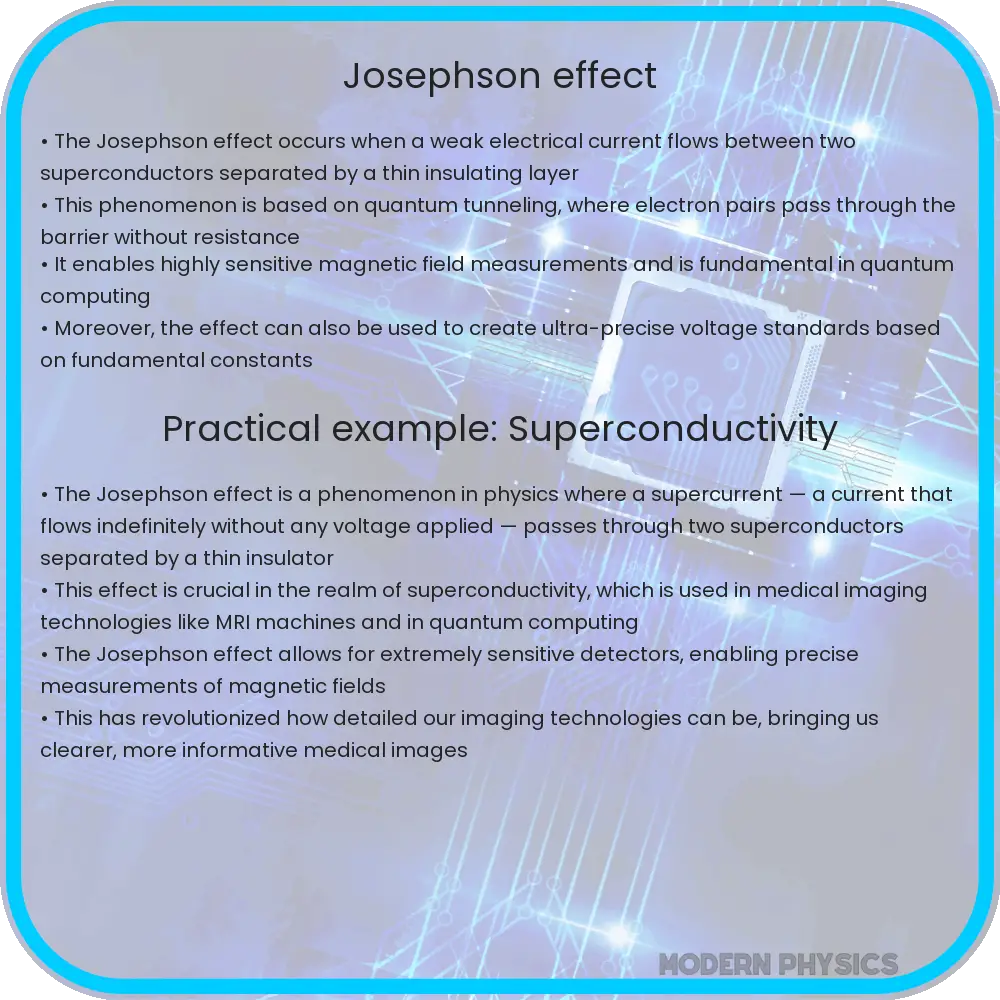The Josephson Effect involves a supercurrent flowing through two superconductors separated by a non-conductive barrier, fundamental to quantum physics and technological applications.

Understanding the Josephson Effect
The Josephson Effect is a fundamental phenomenon in the realm of quantum physics and superconductivity. Discovered in 1962 by British physicist Brian Josephson, it relates to the behavior of a supercurrent (a current that flows indefinitely long without any resistance) across two superconducting materials separated by a very thin non-superconducting barrier. This discovery not only deepened the understanding of quantum mechanical phenomena but also had significant implications for various technological applications.
At its core, the Josephson Effect manifests through two primary types of currents: the DC Josephson Effect and the AC Josephson Effect. The DC Josephson Effect entails a constant voltage across the barrier that leads to a direct current without any external electromagnetic influence. Conversely, the AC Josephson Effect occurs under a constant current flow facilitated by an external voltage application, which causes an oscillating supercurrent across the junction.
Mathematical Representation
The behavior of the Josephson junction can be described by the Josephson relations. The first Josephson equation, describing the DC Josephson Effect, is given as:
\[ I = I_c \sin(\delta) \]
Where I is the supercurrent, Ic is the critical current (the maximum current that the junction can support without losing its superconductivity), and δ is the phase difference between the quantum mechanical wave functions of the superconductors on either side of the barrier.
The second Josephson relation, relevant to the AC Josephson Effect, explains how the voltage across the junction influences the phase difference over time:
\[ \frac{d\delta}{dt} = \frac{2eV}{\hbar} \]
Here, V represents the voltage across the junction, e is the elementary charge, and \(\hbar\) (h-bar) is the reduced Planck constant. This equation illustrates that the phase difference changes over time when a voltage is applied, leading to an oscillation in the current.
Physical Interpretation and Visualization
To visualize the Josephson Effect, imagine two superconductors as oceans separated by a thin strip of land (the barrier). The pairing of electrons in both superconductors can be thought of as synchronized waves in these oceans. Even though the barrier prevents the bulk flow of water (electrons), the wave’s synchronization allows a “tunneling” through the barrier at a molecular level. The strength and direction of the flow through this tunnel depend on the phase difference between the waves on either side, akin to the phase difference in Josephson’s equations.
Applications of the Josephson Effect
The practical applications of the Josephson Effect are diverse, impacting fields like quantum computing, metrology, and magnetic field sensing. One of the most noteworthy uses is in the design of superconducting quantum interference devices (SQUIDs), which are highly sensitive magnetometers used in various scientific and medical applications. Additionally, the precise nature of the AC Josephson Effect’s dependence on voltage and frequency has been employed in creating voltage standards based on fundamental constants, enhancing the accuracy of electrical measurements globally.
Josephson junctions also play a crucial role in the realm of quantum computing, where they serve as the basic elements of qubits (quantum bits), the fundamental units of quantum information. Their ability to maintain coherence between quantum states and to be manipulated by external voltages makes them ideal components in the construction of quantum logic gates.
Challenges and Future Perspectives
Despite the broad utility of the Josephson Effect, implementing this phenomenon in practical devices presents several challenges. One major hurdle is maintaining the superconductivity state, which requires extremely low temperatures. This dependency limits the portability and practicality of devices based on the Josephson Effect, especially in environments outside specialized laboratories.
However, ongoing research aims to discover new materials and methods to achieve superconductivity at higher temperatures, which could potentially broaden the applicability of Josephson-based technologies. Additionally, advancements in nano-fabrication and cryogenic engineering are expected to enhance the stability and efficiency of these devices.
Another area of focus is the integration of Josephson junctions with other quantum phenomena and devices. Current research includes exploring hybrid systems that combine multiple quantum mechanical effects, which could lead to new functionalities in quantum computing and sensing technologies.
- Exploration of novel superconducting materials.
- Advances in cryogenic cooling techniques.
- Integration with other quantum technologies.
Conclusion
The Josephson Effect is a cornerstone of quantum physics and superconductivity, offering profound insights into the quantum world and enabling a host of technological applications. From the precise measurement of magnetic fields using SQUIDs to the foundational technology behind quantum computing, the implications of the Josephson Effect are both broad and impactful. As researchers continue to tackle the challenges of implementing this phenomenon, the future may hold even more revolutionary applications, enhancing the role of quantum mechanics in modern technology.
Whether for the seasoned physicist or the curious learner, the Josephson Effect is a dazzling example of how abstract quantum phenomena can have tangible, real-world applications, bridging the gap between theoretical physics and practical engineering.
